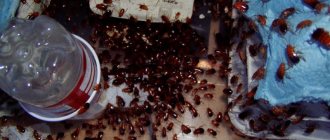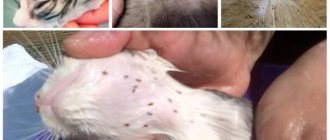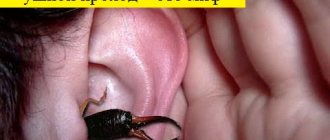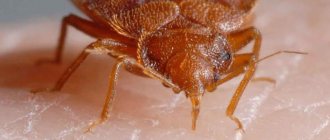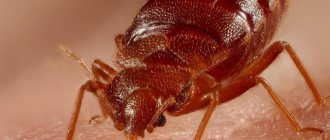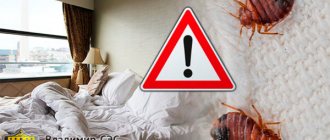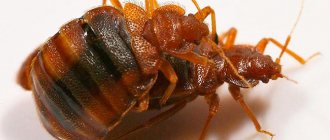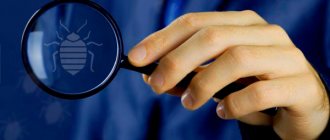Anatomical abilities of domestic parasites
Whether bed bugs fly can be determined by their appearance by carefully examining the parasite with a magnifying glass. Flat, flattened body, elastic chitinous cover. There are no wings or fender liners. The question can be answered with complete confidence - domestic bloodsuckers do not fly.
Interesting!
Small insects are able to freely climb on any surface - horizontally, vertically. The bloodsuckers climb onto the ceiling and from there they attack the sleeping person. Parasites float in the air, and for this they do not need wings.
Bedbugs enter a house or apartment not through open windows or doors, but through contaminated things, furniture, and objects. Or through cracks in the wall, sockets, ventilation grilles from neighbors. They parasitize in bed when the victim is sleeping. Photos of pests are presented below.
Are there bedbugs with wings (flying bugs)
Such insects exist. They have full-fledged wings that allow them to rise into the air and fly. However, many insects had wings at the initial stage of evolution and then disappeared. This group includes bed bugs. Other insects have wings only at the initial stage of development, such as stick water striders.
Due to wintering
they lose the ability to fly. This is due to the fact that the muscles responsible for the functioning of the wings atrophy, because they were not needed for a long period.
If you are wondering whether bedbugs fly or not, you need to take into account that in some insects, due to evolution, only the elytra have been preserved. However, these are inferior wings; their capabilities are not enough to fly. It is not always possible to detect the elytra, since they are camouflaged due to the pattern on the shell.
Interesting: Not all types of flying bugs use their capabilities; they fly very rarely, such as the green bug, and the wing on its back is also difficult to see.
The most common flying bugs that constantly move through the air are:
- triatomine, found in America, rarely in Russia, lives close to human habitation, goes hunting when it gets dark;
- smoothy (water flying bug) - lives near bodies of water, is characterized by a black color, up to 4 cm long;
- marbled crop pest - found in Asia, can destroy plantings, moves long distances;
- stick water strider: acquires the ability to fly when it turns from a nymph to an adult (from a larva to an adult), during wintering the muscles atrophy, in addition, they are used by the body as a source of nutrients, they are simply digested, so in the future the pest loses the ability to fly;
- The turtle bug got its name due to its resemblance to a turtle; this insect destroys agricultural crops.
Triatomine bug The bite of the smoothie bug is not poisonous, but quite painful. Under the hard shell of the marbled bug there are wings. WAND- water strider Hydrometra gracilenta Externally, the shape of the shell resembles a small turtle
Most flying insects feed on plants. They do not settle in human homes, but they can accidentally fly through a window. In such conditions they will not survive due to lack of food. Upon contact, pests release substances that repel enemies.
It's an intense smell.
All types of bedbugs have this ability.
Are they dangerous?
House bugs cannot fly. Previously, insects fed on the blood of bats, moving with them over distances. There was no need for flights.
When they enter people's homes, bedbugs use agility and flexibility to get into hard-to-reach places. If they had wings, they would interfere with such maneuvers. Insects move at a speed of about 2 meters per minute, so there is no need to move through the air.
Despite the presence of wings, many bedbugs cannot fly, since this part of their body is poorly developed. Certain types of insects initially still move through the air, but over the course of their lives this ability gradually fades away.
A subspecies of the bug, the stick-shaped water strider, initially knows how to fly, but after overwintering it loses this function. In winter, under the influence of low temperatures, the muscles used during flight become deformed and dissolve.
The soldier bug has elytra, but it is impossible to fly with them.
The Woodbug has not only elytra, but also hind wings. But they are not sufficiently developed, since insects rarely rise into the air.
Winged bugs differ from their flightless counterparts by their large size. Their bodies come in different shades: brown, gray, green. Wings are clearly visible on the back.
Flying bugs, which live in Eurasia, pose almost no danger to humans. In rare cases, they end up in a home, hiding from bad weather, or by accident, during flights to another place. Many species of flying bugs feed on plants, but human blood is of no interest to them.
Even if bedbugs cannot fly, this does not mean that they will not enter a person’s house through a window. Do not discount their agility and ability to penetrate even narrow cracks.
Don't panic if you find bedbugs with wings in your home. These are nothing more than accidentally flying insects. They do not pose a threat to human health, since they do not feed on human blood. Their defensive reaction is an unpleasant odor liquid that pests secrete in cases of danger. But winged insects can cause harm in the garden. So green pests spoil fruit and berry plants, red pests spoil tree bark.
Forest
Flying bugs are much larger than their bed bugs. Most often there is a brown bug with wings or individuals with a greenish tint. Below is a photo of a flying creature, where its wings are clearly visible. A massive invasion of pests begins with the arrival of cold weather: they attack human housing in search of warmth and food. Even the height of high-rise buildings is not an obstacle for uninvited guests. They easily master the last floors.
Knowing the answer to the question of whether bedbugs can fly, you can easily determine the type of annoying tenants that have appeared in the house. If these are creatures with wings, then it is easy to catch them with a matchbox and release them on the street. If they suddenly turn out to be bed bugs, you should immediately begin the fight against bedbugs.
Wild flying
Bedbug populations are numerous. Among tens of thousands of species, some individuals can fly. They have a well-developed pair of real wings, due to which they move through the air.
Flying bugs:
- Triatomine is a representative of hemipterans. Individuals are dangerous to humans. A bite can spread the deadly Chagas disease. They live in America. In Russia there are single specimens. The tropical insect has a pair of wings. Predators settle near human habitation: in sheds, attics, and courtyard buildings. With the onset of darkness, they fly closer to the prey, which are people. The bug feeds on blood.
- Marbled pest of crops. Spotted in Asia. Destroys melons and berries, loves vineyards and nightshades. To move long distances you need wings.
- The smooth water flying bug is a black insect, reaching 3-4 cm in length. It has smooth, hard wing covers. The bite is not dangerous to humans, but the pain is comparable to a wasp sting. Fighting the pest is useless, since families fly across the reservoir very quickly.
- Stick water strider. It has a laterally flattened abdomen and long legs. From the moment the nymph transforms into an adult, the bug can fly. After wintering, this ability disappears in the water strider. The muscles responsible for the movement of the wings atrophy, are digested during hibernation and are used as additional nutrition.
- Turtle. A small brown stink bug that is a pest on farmland. Outwardly it resembles a small turtle.
Triatomine Smooth Turtle
There are more flying bugs than those without wings. There is no danger to humans. The harmfulness lies in eating vegetation. If you catch a bug, you can “get it in the nose,” since all flying and flightless insects emit an unpleasant odor to scare away the enemy.
Important! If adult representatives are equipped with a flying machine, their larvae do not have wings. Over time, it is noticeable how the nymphs begin to develop elytra.
If you find a flying guest, do not worry. This is an outdoor insect that flew into an open window. Entomologists say insects need wings to move from one territory to another in search of food, from danger, and for settlement. Their flight is short, since the muscles of the wings are rather weak.
The flying representatives of the order look larger than the crawling ones. Most often you can meet them in the fall, when, with the onset of cold weather, they fly into apartments in search of food and shelter from the cold. In private houses the likelihood of such a meeting is higher than in high-rise buildings. Street insects fly to places where there is a lot of tasty greenery.
General information about bedbugs
Some types of parasites differ from each other in the following ways:
- lifestyle;
- nutritional characteristics;
- appearance.
Representatives of hemiptera have the same structure of the oral cavity. Some species feed on plant sap or human blood.
Parasites have a distinctive feature - they emit an unpleasant odor, which is formed as a result of the functioning of special glands located on the belly of the bug between the first and second pair of limbs. The aroma of the secreted liquid repels other insects.
The garden is inhabited by soldier bugs that destroy pests. Representatives of the Podisus species feed on Colorado potato beetles, and the turtle bug damages seedlings and young trees. Many species of the suborder Hemiptera consume the blood of animals, birds, bats, and humans. The clothing bug belongs to them.
Features of domestic bloodsuckers
An insect that lives in bed or linen cannot exist in an environment other than human habitation. Bed bugs have a size of no more than 8 mm, a flattened abdomen, which slightly expands on the sides.
Domestic bugs have defective wings; their capabilities are not enough to fly.
During its development, the bloodsucker goes through a stage of incomplete transformation. Nymphs hatch from eggs; the larvae are much smaller than the mother and do not have wings.
Linen parasites crawl along walls and ceilings in search of food, using a small proboscis to pierce human skin. Representatives of the order Hemiptera feed at night, being particularly active at 4-5 am.
Insects have a good sense of smell and identify food sources by smell.
The bug quickly finds small capillary vessels, pierces the skin, injecting an anesthetic composition.
Having drunk blood, it moves along the surface of the body 2-3 cm and bites the person again, continuing the process of saturation.
How long do house bugs live?
The average lifespan of a bed bug is 10-12 months. In particularly extreme conditions (for example, during a sharp cold snap or the absence of a person in the house for a long time), they fall into suspended animation, in which they can remain for more than a year until the return of a source of food or normalization of external climatic conditions.
IMPORTANT! Household bugs are also called bed bugs, and their clutches instantly die at temperatures of +50°C and -10°C.
Lifestyle
Bed bugs are predominantly nocturnal. Only a certain danger or alarm can force them to become active during the daytime, for example, destruction of their habitat or the action of third-party chemicals.
The parasites are most active between 3 am and 6 am. At this time, they are especially dangerous for humans, since they go out in search of food, this is their feature. Insects are mobile and fast, they can get from any corner of the apartment to the bed in a matter of seconds, spend about half an hour feeding and return to their previous shelter.
Bed bugs spend most of their life cycle preferring to hide in various shelters, emerging at night to satisfy their hunger or to find a new home if the old one has been destroyed.
IMPORTANT! Parasites usually eat once every 5-7 days. If you notice new bites on your body every day, this is a sure signal that there are a huge number of parasites in the house.
After a single feeding, bedbugs digest the blood somewhere in a secluded corner of the home.
Reproduction and development
Bed bugs mate through traumatic insemination:
- The male, using his genital organ, pierces the female’s abdomen and injects seminal fluid into it.
- After a few weeks, the female begins to lay eggs (up to 5 eggs daily). Over the entire life cycle, one adult female is capable of laying about 250-500 eggs.
- An insect in an egg will develop to the adult stage on average 30-45 days, but in extreme conditions development can take up to 100 days.
- Bedbug larvae immediately begin to look for food on their own, because to move to the next stage of development (and to molt) they need a certain amount of blood they drink.
Danger to humans
To understand the degree of danger, you should thoroughly study the structure of the bug - both external and internal. On the pages of a school biology textbook you can find comprehensive information about the suborder of blood-sucking insects, of which bedbugs are a prominent representative. Biologists classify them as belonging to the order of hemipteran insects. This order of insects is considered one of the most numerous and widespread.
Bed bugs are a rather harmful type of insect. They range in size from 3 to 5 millimeters in length.
Parasites have a flat body, it is combined in color, but most often it is reddish-brown and has a brown tint. The body of the bug is always covered with thick hairs. Such details of the external structure can be observed if the insect is examined closely, for example, using the capabilities of a microscope or magnifying glass.
Bedbugs reproduce “at the speed of light.” This happens especially quickly at optimal temperatures and at night. The optimal temperature for their reproduction is 18-25 degrees above zero. As you can see, the usual room temperature.
Bed bugs develop through an incomplete transformation cycle. What does it mean? The female goes through the process of her development in several stages: egg - larva - mature individual.
The laid egg and the larva that appears after a while do not cause harm. All the strength appears in the bug when it turns into a large, fully formed individual.
The peculiarity of bedbugs that allows them to turn an ordinary residential apartment into a dangerous “infected” area is the ability to reproduce numerously. Just imagine, one mature female lays about 15 new eggs per day. And in two days? And in a month?.. One individual can live for a calendar year. This means that in just a month there is no longer just one female in the house, but a whole colonial detachment. If this happens, the apartment is not only dangerous, it is “catastrophically infested” with these parasitic insects.
The dependence is straightforward. Remember, the more parasitic “tenants” you have, the more dangerous the consequences of their attack and influence.
Relationships between insects
The house bug is a small individual whose body has a flattened shape. The body is from 2 mm to 8 mm long. After feeding, the size of the bug increases in proportion to the blood it drinks. The parasite is brown or black in color. After eating, it takes on a scarlet or burgundy hue. There is a sting to pierce the skin and suck out blood. The bite of a bug is not felt by humans or animals thanks to a special substance produced by the bloodsucker's gland.
House bugs
The insect has a standard set of legs in the amount of 3 pairs. Their structure allows the bloodsucker to move quickly, and their flat body makes it possible to get into the narrowest crevices. This ability quickly disappears after the bedbug takes food. A well-fed individual is passive, moves very slowly and reluctantly.
The relationship between bloodsucking bugs and other insects that live in apartments is very complex. Due to constant bites on the body, people often resort to fighting bloodsuckers. While with ants and cockroaches it can live for a long time. Insects also become dangerous to each other. What can happen between parasites:
- Cockroaches enjoy feasting on bedbug eggs. Regardless of the fact that the habitats of these pests are different, the larvae of cockroaches are able to penetrate into the shelters of bloodsuckers and destroy their clutch.
- The poisonous glands of ants are fatal to the bug. They do not purposefully fight among themselves, but parasites cannot settle nearby. In addition, adult ants are also not averse to eating beetle larvae.
- Centipedes happily catch and kill even adult bloodsuckers. However, the centipede itself is a rare occurrence in human habitation.
Bedbugs themselves cannot harm anyone except people. Interestingly! Cats hunt for any insects that move around the rooms, but do not pay any attention to bedbugs. This may be due to the specific smell of the parasite.
The possibility of insects appearing in the house due to exterminators
Chemical treatment of the premises forces parasites to leave their habitat. Individuals that did not die during disinfestation crawl into neighboring apartments located in multi-story buildings. Bed bugs do not leave their habitat if disinfestation was carried out unprofessionally, or during work they used drugs to which the pests have become resistant.
The survivors after disinfestation begin to seek shelter in other apartments.
Blood-sucking insects can re-enter the room after chemical treatment if there were too many of them and the poison did not reach the hiding places of the individuals.
How to deal with flying and non-flying bedbugs
To destroy flying insects, do not use special means, because they move quickly. In addition, they are not found in large numbers indoors. If one pest gets into the house through a window, it is destroyed mechanically (with a slipper or other heavy object) when the insect sits somewhere.
Often street bugs die indoors from lack of food.
How to destroy bedbugs: folk methods
In farmland conditions, bedbugs are destroyed in different ways: traps made from plastic bottles and sweet baits are used. However, bed bugs cannot be killed in this way, because they do not react to other food sources, they are attracted to blood. At home, they are destroyed using kerosene, denatured alcohol, naphthalene, and turpentine.
Each of the components can be used
separately or make a mixture. This product is used to treat bedbug nests and various surfaces.
Be sure to follow safety precautions when working with denatured alcohol.
Do bed bugs jump or not?
Hello dear readers! Today we will again touch on the topic of bedbugs, debunking several myths about these insects, because many people believe in something that actually does not exist. And in particular, many are interested in whether bedbugs jump, what species can jump and how high.
Simple myths
The mere mention of the word “bug” causes goosebumps, discomfort, or even hysteria for many. Indeed, bedbugs cannot be called attractive insects, because the resemblance to cockroaches and the knowledge that they drink blood at night do not evoke positive emotions. But despite all their negativity, they are not as scary as many imagine.
Therefore, I would like to dispel several myths about bloodsuckers:
- Only a person with very good eyesight can see domestic bedbugs - both the larvae and the bloodsuckers themselves are of a fairly small size. Only a sufficiently mature creature will be seen by the human eye.
- Don’t think that there will never be bloodsuckers in a clean apartment; they are not only lovers of unsanitary conditions. They prefer places where it is warm enough, where there is blood and carbon dioxide.
- These creatures will never attack if the light is on in the room - in reality, this does not always coincide. They try to feed at night, but in order not to remain hungry, insects are able to overcome their fear of light.
- Blood-sucking creatures jump like fleas and are thus able to move around the apartment perfectly. It is this main topic of our article that we should now dwell on in more detail.
Are bed bugs ready to jump?
Many of us have become acquainted with these insects, and it is well known how much harm it can cause. But not everyone can answer the question: do these parasites jump or crawl?
https://youtube.com/watch?v=eXVyg_r5K7Q
But the legs of bedbugs are completely unprepared for jumping; they have a completely different structure and, accordingly, purpose. Therefore, neither adults nor small nymphs are able to jump.
The Spanish bug is capable of running, but only for short distances. The speed of movement is 1 meter per minute. What is natural: they do not need to run long distances, because they live close to humans.
Therefore, housing and food can be said to be conveniently located for these bloodsuckers.
Can these creatures fly? - The answer is obvious: no! They have no wings and no ability to fly. Therefore, you should not be afraid that they will land on your head or fly into your apartment through the window.
The bed type is the most common among all types, but therefore there are many methods to combat it. So what kind of bloodsucking creatures jump?
Jumping types
If you figure out how many types of bedbugs exist all over the world, it will be difficult to count them all. But those that can jump include a small number of these creatures.
The following types of them bounce:
- Water strider - able to move through water by jumping short distances. From the name alone it’s easy to understand what his jumps look like. From the outside, it seems that he is simply measuring the water in small passages. The ability to jump is well developed, and is needed not to get on clothes, but to obtain food in its environment. This species is not dangerous to humans.
- Coastal lizards or coastal lards can gallop long distances. Their jumping is sometimes mistaken for flying. The jump is necessary for coastal dwellers because they are predators and hunt invertebrates.
- Shieldbills and edgeworms can jump on people, but do not harm humans. We can often meet them in the garden or vegetable garden. They not only jump well, but also fly.
- Triatoms are dangerous for you and me, they can carry a fatal disease called Chagas disease. They live mainly in the tropics of Central and South America.
We figured out whether these parasites can jump, and came to the conclusion: bed parasites cannot. Unfortunately, this does not make them any less harmless.
A lot can be said about the dangers of these blood-sucking bugs: bites that cause allergies and other diseases, the inability to sleep, either from the bite, or from the fear that a bug is nearby.
And when you see a creature on the sofa, don’t guess: it suddenly jumped, they just fall from the ceiling of your house. But don’t despair: you can overcome these mini-predators by turning to professionals.
What to remember
- House bugs cannot jump or fly.
- Species of jumping insects exist, but only the triatomine, which does not live in Europe, poses a danger to humans.
- Blood-sucking bugs move short distances in dashes.
- Insects do not always breed in unsanitary conditions; dust and dirt simply encourage their reproduction.
See you in the next article!
How do bedbugs fly around the world?
Bedbugs seem to suddenly appear uninvited out of nowhere. Because of their sudden appearance, some people ask themselves: “Did bedbugs fly into a window or an open balcony door?” Luckily, no, bed bugs cannot fly.
But bed bloodsuckers crawl perfectly on six legs, so they don’t need wings. Any rapid transportation of bed bugs may be associated with human activity, which becomes not only their food, but also their personal means of transport. They attach to your luggage, clothes or even your skin and travel with you in the car, on the bus, on the train, or on the plane.
We don’t end our search on the bed...
In our practice, we were sometimes able to find bedbugs in completely unexpected places. I’m not talking about baseboards and under parquet floors - they are almost always there. But it happens that their nests are found behind books on shelves and behind the shelves themselves, inside laptops and computer system units, behind pictures on the walls, in safes, in sockets, in old things that people have not worn for a long time.
Simply put, the bed is just the beginning. This is where you discover bedbugs and this is where you start looking for them. And where you will find all the other nests is very difficult to say. The main thing is to understand that bedbugs are not only infested in beds. It’s very, very rare that this happens: they are in the bed, but not anywhere else.
Now. You found bedbugs in the bed. This means that you need to look for them in the entire room, and preferably in the entire apartment. Here you need to inspect all the cracks, holes, cavities where they can physically get into. The following rule works here: the more difficult it is for you to get to a particular bedbug shelter, the more likely they are to have a nest there.
In our practice, we were sometimes able to find bedbugs in completely unexpected places. I’m not talking about baseboards and under parquet floors - they are almost always there. But it happens that their nests are found behind books on shelves and behind the shelves themselves, inside laptops and computer system units, behind pictures on the walls, in safes, in sockets, in old things that people have not worn for a long time.
It is not possible to get rid of ticks completely and forever; the main rule is to keep the house clean and carefully care for bedding.
What will help get rid of dust microorganisms in pillows:
- Ideally, replace down and feather products with accessories with synthetic filling: padding polyester, holofiber, comforter, which must be washed once every six months at temperatures above 50 °C.
- If you don’t want to part with natural materials, or for children, you can choose an alternative with the following fillings: buckwheat husk, bamboo or coconut fiber, latex.
Fans of fluff and feathers can bring out “guests” in several ways:
- Airing the pillows in the air for at least 5–6 hours gives a temporary effect. In winter - in frost, in summer - in direct sunlight. This method does not work for long, since tick eggs are insensitive to heat and cold, only adult individuals die.
- Once a year it is worth disinfecting such products with special dry cleaning products.
- You can also clean the pillow yourself. The bedstead needs to be washed, ironed (or replaced). Down filling - treat with a soap solution (100 g of laundry soap, 100 g of ammonia per 10 liters of water), rinse thoroughly and dry, then put the product back together.
It is worth noting that it is impossible to get rid of dust mites by cleaning only the bed linen. Additionally, you need to weaken the provoking factor:
- sort out deposits of soft toys;
- reduce the number of carpets and curtains;
- Follow the rules for storing winter clothes.
Also, during wet cleaning, you can add special antiparasitic agents.
Flying bugs in the apartment
Flying bugs look much larger than bed bugs. The color of their back is from gray-brown to green. The wings are clearly visible.
Street bugs bother residents in apartments in the spring or summer. And in warm regions, bedbugs fly en masse into apartments, houses and gardens in the fall, especially after a hot and rainy summer. These individuals are herbivores and can cause minor damage to plants in the garden. The flying bugs' season ends around October or November - at the same time that they begin searching for food and warm places in people's homes. A massive invasion usually does not last long - 3-4 weeks, in rare cases - up to 2 months. Even high floors in apartment buildings are not protected from large numbers of flying bugs entering an apartment, especially if the house is located near a forest or park.
For prevention, traps can be used as a measure to reduce the number of this species within the home. One of the homemade options is a trap for flying insects in the form of a cut-off plastic bottle, closed with a lid with a narrow hole. A sprig of raspberry or other plant should be placed inside the bottle, or sugar syrup mixed with the berry should be poured. As a trap for flying bugs, you can try laying out ready-made poisonous boxes for cockroaches with luring substances inside. However, the effectiveness of this method is questionable, since the attractants contain substances that are not preferred by stink bugs.
It is quite difficult to completely get rid of flying bugs in an apartment, because they will still fly towards the heat. Entomologists usually advise just waiting out the season of their vigorous activity, and besides, it is not that long. During the period of invasion, you can try to remove bedbugs that fly with repellents and regular cleaning.
To find out what kind of plant you can plant in your yard to prevent bedbugs from getting into your house, watch the video.
Fighting a blood-sucking parasite
A person fights bedbugs throughout his life. In the Middle Ages, Europe was simply overrun by bedbugs. They lived everywhere, from shacks to palaces. Special devices with specific names: bug cookers and bug burners were filled with coal, water came out as steam through the spout and burned the hated insects.
Modern control methods are more effective:
- Chemical method. Modern drugs are the most effective means, most of them do not harm humans. It is best to carry out the treatment in the morning, in children's institutions - before the weekend. If individuals have just appeared, you can treat only their habitats. In case of a mass invasion, it is necessary to fight throughout the entire territory.
- Physical methods have been used throughout human history. It started with the blow of a slipper, and now it is a powerful vacuum cleaner, with the help of which they try to get insects from the most hidden corners of furniture.
- The insect's reaction to high temperatures makes it possible to get rid of insects using temperature treatment of things during washing and ironing. A greater effect can be achieved with the help of industrial hair dryers and heat generators, as well as by freezing the room.
- Among the new methods, it is proposed to use a fungus that infects individuals and leads to their death.
- Biological agents are effective, such as new parasites that lay eggs in the body of the bedbug larva.
- The easiest way is to call the sanitary and epidemiological service for help. This is an effective method, because it is not just a single apartment that needs to be treated, but the entire house.
- The safest but least effective are folk remedies. Plants such as wormwood and tansy can be placed throughout all rooms, in the most inaccessible places. To determine the habitat, you can sprinkle flour on the floor - in the morning there will be traces of insects on it.
Useful linksHow to disinfect bedbugs in an apartment can be found here.
How to deal with them
The pest's lifestyle depends on the development of its wings. When a bug eats vegetation, it needs to travel long distances. If the individual is near the victim, then it does not need the ability to fly.
The control method is chosen depending on the type of parasite - flying or crawling. They get rid of flying creatures using traps and special repellers.
A crawling bug is harder to catch because it hides. To eliminate it, you will need disinfestation agents. The fight is against pests that destroy berry plantings and farmland, as well as against domestic blood-sucking insects. When a room is infested with many individuals and you don’t know how to get rid of them, you need to contact special services.
At home, you can install a sticky trap, sweet fertilizer, tape, or a do-it-yourself device made from a plastic bottle.
There is no point in fighting one flying bug. It must be caught, released into the street or destroyed. To prevent insects from disturbing them, mosquito nets are installed on the windows, cracks on the window frame and balcony are sealed with sealant, and a cloth soaked in vinegar is laid out on the windowsill. If the bedbugs do not disappear, then insecticides are used.
Where did bedbugs come from?
If bedbugs entered the apartment from neighbors on the upper or lower floor, it is not so easy to establish the exact migration paths of the insects. Parasites move through microcracks in the floor or ceiling in places where water supply, sewer, gas or heating pipes, ventilation openings, and electrical wiring ducts pass.
One can only guess what specific routes the bedbugs took. This is influenced by the layout of the bedrooms and the degree of infection of the adjacent apartment. For example, if your neighbors have been living with bedbugs for more than one year, then the parasites have probably already infested both the kitchen and the bathroom, which means they can crawl in from anywhere. As a rule, bedbugs come from neighbors precisely because of the “overpopulation” of the colony.
If bedbugs moved into the house on new furniture, purchased in a store or from your hands, then again the situation will depend on the degree of infestation. Some sell furniture at an attractively low price because there are parasites in it. Naturally, they keep silent about this during the sale. If the population of bedbugs in such a sofa was more than three generations, then once inside the house, the insects will soon begin to look for new shelters.
If the owner accidentally brought one or two bloodsuckers on himself from a trip or from guests, then, most likely, for the first 20-30 days, the localization of the infection will be limited to one room or even one sleeping place. But there can be no 100% certainty in this matter.
Symptoms of infection
The most obvious evidence that there are bed bugs in the house is the discovery of an adult bed bug. At the same time, sometimes a living insect may indicate that the neighbors are being disinfested, and the surviving bloodsuckers have found a new home. Thus, when an adult is identified, the potential habitats of these parasites should be immediately inspected.
Bites on the body
The main symptom of bedbug infestation is bites that regularly appear on the skin. Red marks appear on the neck, back, cheeks and arms. Parasites do not bite in hairy areas; they choose places where the skin is thin and smooth. For this reason, children and women suffer more from these insects.
Bed bugs become active at night, so new bites can be detected in the morning immediately after waking up. Small red bumps are sometimes confused with an allergic reaction.
In this case, the bedbug bites are close to each other, forming a path. The number of red bumps on the skin increases every day along with the insect population, which is rapidly increasing. If the fight against parasites is not carried out, then a person can be bitten up to 300-350 times during the night.
Traces of blood on the bed
The substance that the parasite injects under the victim’s skin disrupts blood clotting. For this reason, a drop of blood appears at the site of the lesion, which, falling on the bed, leaves a mark. Bedding and waste products contaminate.
To remove stains, rinse the fabric in cold water. You can also remove traces with hydrogen peroxide (3-5%).
Hydrogen peroxide removes traces of blood stains after a bug bite.
The appearance of blackheads
Bedbugs are living creatures, so they have a digestive process and waste. Parasite feces are liquid and dark brown in color, but they quickly cool and become hard.
You can find excrement anywhere in your home. Most often, parasites accumulate near or on the bed. The smell of bedbug waste resembles bad cognac.
When the larva hatches from the egg, it molts several times as it grows. Each time it sheds its chitinous coating, which can be found on the floor, furniture, and windowsill.
Unpleasant smell
The sense of smell is a way for bedbugs to navigate in space, mate and notify their relatives of danger.
The aroma that these parasites exude is pleasant - sickly sweet, reminiscent of the smell of almonds or rotten raspberries. If there are a lot of insects in the apartment, the aroma becomes constant. If you smell this smell at least once in your life, you will no longer be able to confuse it with any other.
Drugs and preventive measures
Regular washing of bedding and ironing helps to effectively cope with parasites. But not all fabrics can be washed at high temperatures and ironed. To neutralize allergens and cope with mites at any temperature, a special Acaril liquid is added to the washing machine. The same product, released in powder form, can be used to clean carpets.
Wet cleaning is the main weapon in the fight against dust and its inhabitants. Its effect can be enhanced by adding special All-Rug shampoo to the water. The product is sold as a concentrate and can be used to clean natural and synthetic pile of furniture and carpets. It is used in a washing vacuum cleaner and for manual cleaning. The drug is diluted 1:30 in the first month, then a solution of 1:60 is sufficient. The product removes dirt, allergens and mold well, and has a pleasant aroma.
Allergoff spray is capable of destroying parasites at any stage of development. The aerosol form makes it easy to treat mattresses, blankets, carpets and upholstered furniture. The action of the acaricidal drug causes the death of mites in down pillows 1 hour after spraying. Bedding must be treated from all sides.
Spray "Akarosan" when sprayed, penetrates into the body of dust mites when feeding and through the chitinous shell. The main active ingredient of the drug is benzyl benzoate. The spray enlarges arthropod excrement, allowing it to be collected with a vacuum cleaner. Particles of the drug remain in the structure of the treated surface for a long time. They have a detrimental effect on subsequent generations of ticks. The protective effect of Akarosan is 6-9 months.
Folk recipe
There are specially developed formulations that help fight feather mites. Sanitation services treat premises with solutions that are safe for people, but have a negative effect on insects. But you can also purchase anti-tick chemicals yourself, diluting them strictly according to the instructions. Effective drugs include:
- Tsifekos powder, which is diluted in water, eliminates feather mites for one month.
- Emulsion Sipaz means for disinfection in residential premises. Fights insects for 30 – 45 days.
- Based on medicinal herbs, there are sprays for treating bed linen that eliminate feather mites in three hours.
- Easy Air product, developed based on natural ingredients.
- Allerqoff spray for treating mattresses, carpets, and upholstered furniture helps reduce the number of mites.
We suggest you read: Can lice jump?
Interesting facts about insects
The first record of a bedbug was found in chronicles of the 400s. BC e. Aristotle claimed that these insects could cure the effects of a snake bite and get rid of ear infections. In the 18th century, bedbugs were used for medical purposes as a remedy for hysteria. In the 19th century began to invent ways to combat parasites - “bug cookers”, rubbing with perfume and even special spells.
In Thailand, large water bugs are a tasty treat offered to tourists in expensive restaurants and street stalls.
Predatory bugs Acanthaspis petax hunt ants, whose skins they wear on their backs. A kind of shield scares away spiders, which will never attack ants that have accumulated in large numbers.
The water bug Micronecta scholtzi is capable of producing a sound with a volume of up to 99.2 dB, which is comparable to the roar of a moving locomotive. Males chirp to attract females. To do this, they scratch their belly with their genitals. However, a person does not hear these sounds, because all the action takes place under water.
Pest running speed
Bedbugs move at a speed of 1 m per minute. Small larvae move more slowly, so they live near human sleeping places so as not to move long distances at night.
House bugs move exclusively in one way - crawling from place to place.
During the migration period, domestic parasites travel long distances. In 24 hours, moving through a ventilation shaft, bedbugs crawl several hundred meters.
Domestic bloodsuckers move slower than cockroaches. Predatory bugs of the Antacoris species, living in tropical countries, move faster than linen bugs and attack sedentary insects - mollusks, caterpillars, larvae.
